Released forty years ago (11/2/81) with little fanfare and even less explanation, Re·ac·tor is the fourth studio collaboration between the Canadian rock icon and the band Crazy Horse. His last album released through Reprise Records before he moved to Geffen for his next five LPs, with the hindsight of four decades, its overly-repetitious approach did not bode well for the imminent future of Young’s career (as it indeed turned out: see the relative ups and downs of Trans, Old Ways, Everybody’s Rockin’, Landing On Water and Life).
In fact, the whole package reeks of contractual obligation fulfillment. Raucous feedback-drenched riff-songs are generally static, the monotony of which might be alleviated by more of the spontaneous improvisation so prominent on the same ensemble’s inaugural 1975 effort Zuma. The monochromatic tones of the musicianship are in vivid contrast to the package’s bold red and black color cover scheme; unavailable on compact disc until 2003 upon release as part of the ‘Neil Young Archives Digital Masterpiece Series,’ the twelve-page insert contains musician and production credits juxtaposed with printed lyrics, a confounding move if there ever was one given how offhanded they read (like those Young writes so often these days).
As with the other six numbers, it’s certainly not necessary to peruse a lyric sheet to catch the words to “T-Bone.” Not that anyone might want to quote them anyway, particularly as the singing, mostly in the form of slightly strained caterwauling, is not the most salient component of this album anyway. The sound of the loud guitars and clattering drums virtually drown out vocals far more akin to shouting than the dulcet and vulnerable tones Young perfected roughly ten years earlier in his solo career, circa After The Gold Rush. In general, compared to the varied textures and imagistic likes of material and musicianship on Rust Never Sleeps from just two years prior, the lack of substance on this LP is bewildering.
Or at least so it would all seem on first glance and hearing(s). But, as usual with this chameleonic artist, there’s more going on beneath the surface than casual observation might reveal. While Re·ac·tor might be interpreted as an after the fact, knee-jerk act of self-defense against punk accusations of obsolescence, there are hints it’s actually Young’s own riposte to ageism in . Listen to the refrain of the opener “Motor City,” then see if it doesn’t echo through to “Rapid Transit” where the man squalls “Every wave is new til it breaks.” Likewise, “Shots” resonates with a contemporaneous relevance: in that context, Neil is not just talking just about gunfire, but the potshots that dominate public discourse, social media and otherwise. No wonder he and his favorite (?) band sound so agitated and anxious to relieve some tension.
The former Buffalo Springfielder might’ve conceived and executed a more temperate and articulate response to the cultural movements around him. And indeed he would a decade later when he propitiously connected to the grunge with Ragged Glory and its subsequent live albums Arc/Weld (not to mention an actual tour behind and studio recording of Mirror Ball, five years hence, with the movement’s flag bearers Pearl Jam). It’s not that Neil & The Horse hadn’t pummeled us before (Live Rust) or wouldn’t again (Year of the Horse). But here, the sturm und drang is more often than not just an end in itself.
All this corrosive cacophony has its appeal of course. In some cases, like “Southern Pacific”as well as “Surfer Joe & Moe the Sleaze,” it’s beguiling to a point. And there is some respite from this high-volume assault—and Young’s almost indiscernible use of the Synclavier for the first time—in the form of the piano-dominated barrel-house number “Get Back On It;” like more than one number here, a blues derivative of sorts, it’s too short (at 2:19) to keep the rest of this slightly less than forty minutes from blurring together.
It may be giving an overly generous benefit of the doubt to say Re·ac·tor would pass for Young and Crazy Horse simply warming up in preparation for a more formal recording session devoted to some substantial material. But given its timeline within Neil’s even more extended discography now four decades on (including the depths to which he’s plumbed his archives in the interim), it remains one of more than a few conundrums dotting his body of work. Fans and dilettantes alike might well pay close heed to the cryptic inclusion of the ‘Serenity Prayer’ on its back cover.












4 Responses
What a crap review. F minus on the Christgau scale.
I think it got a B from Christgau?
Wonder what he’d give it now after another listen (and forty years)?!?!?
“You are right from your side and I am right from mine…”…Dylan